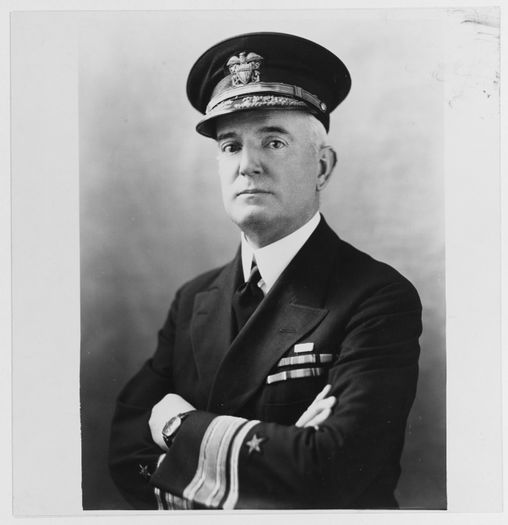WILLIAM A. MOFFETT, RADM, USN
William Moffett '90
Loss
William was lost on April 4, 1933 when the airship USS Akron (ZRS 4) crashed at sea. He was aboard as an observer; he was the Chief of the Bureau of Aeronautics at the time.
Biography
From Naval History and Heritage Command:
William Adger Moffett was born in Charleston, South Carolina, on 31 October 1869. He was appointed Naval Cadet from the First South Carolina District by the Hon. Samuel Dibble and entered the US Naval Academy, Annapolis, Maryland on 6 September 1886. He was graduated on 6 June 1890, and after the two years' sea duty then required by law before commissioning, was commissioned an Ensign in the US Navy on 1 July 1892. His advancement was as follows: Lieutenant (jg), 3 March 1899; Lieutenant, 13 July 1899; Lieutenant Commander, 1 July 1905; Commander, 4 March 1911; Captain, 29 August 1916; and Rear Admiral, to date from 25 July 1921.
Following graduation from the Naval Academy in June 1890, he served successively on board USS Pensacola, USS Baltimore, USS Portsmouth, USS Chicago and on 23 April 1895 he joined USS Amphitrite as Watch and Division Officer. Detached a year later, he was a student at the Naval War College from June to October 1896, then reported to TS Constellation for brief duty, after which he served for two years on board the Nautical School Ship Enterprise.
From January 1898 to February 1899 he had successive service as Watch and Division Officer on board USS Mohican and USS Charleston, serving during the Spanish-American War with Admiral Dewey in the Battle of Manila Bay. He continued sea duty in Charleston, and later USS Baltimore, USS Monongahela, USS Kentucky and USS St. Mary's. On 15 November 1902, he reported to USS Minneapolis for engineering duty, and was transferred to USS Maine upon her commissioning, 29 May 1903. He was detached on 2 June 1904, with orders to duty as Executive Officer of USS Amphitrite.
On 22 April 1904, he assumed command of the Naval Station, Guantanamo, Cuba, with additional duty on board Amphitrite and as Captain of the Yard. He returned to the United States for instruction in the Compass Office of the Bureau of Equipment, Navy Department, Washington, DC, and upon completion of that assignment attended the Summer Conference of Officers at the Naval War College. He returned to the Bureau of Equipment in September 1906, and served there until 31 March 1908.
Duty as Navigator, later as Executive Officer of USS Maryland preceded a tour of shore duty as Inspector of the Eighteenth Lighthouse District, San Francisco, California. On 30 June 1912, he reported to the works of the William Cramp and Sons Ship and Engine Building Company, Philadelphia, Pennsylvania, for duty in connection with fitting out USS Arkansas. He joined that battleship as Executive Officer on her commissioning on 7 July 1912, and served in that capacity until 24 October 1913.
Assuming command of USS Maine on 29 October, he was transferred to command of USS Chester a week later. During the period of his command of Chester, he had additional duty in command of USS North Carolina, USS Brooklyn and the Receiving Ship at Boston, Massachusetts for brief periods. For distinguished service while in command of Chester during the Battle of Vera Cruz, he was awarded the Medal of Honor by Congress.
Relieved of command of Chester on 16 September 1914, he assumed duty as Commandant of the Naval Training Station, Great Lakes, Illinois, and additional duty as Supervisor of the Ninth, Tenth, and Eleventh Naval Districts. He continued his primary duty as Commandant of the Naval Training Station, in the rank of Captain, during the entire World War I period, expanding that previously small station to the largest recruit training depot in the United States, from which most of the trained naval personnel was furnished for all the naval activities during the war period.
He was awarded the Distinguished Service Medal for his wartime accomplishment, the citation stating: "For exceptionally meritorious service in a duty of great responsibility as Commandant of the NINTH, TENTH, and ELEVENTH Naval Districts and Commandant of the Great Lakes Naval Training Station."
On 10 December 1918, shortly after the Armistice, he became Commanding Officer of USS Mississippi, and after two years in that command, he returned to shore duty. On 3 January 1921, he reported to the Office of the Chief of Naval Operations, Navy Department, and on 7 March 1921, assumed duty as Director of Naval Aviation. He was commissioned the first Chief of the Bureau of Aeronautics, with the accompanying rank of Rear Admiral, for a term of four years from 25 July 1921; was reappointed Chief of that Bureau by President Calvin Coolidge on 13 March 1925; and again reappointed by President Herbert Hoover on 13 March 1929.
Having been qualified as a Naval Aviation Observer on 17 June 1922, while serving as Chief of the Bureau of Aeronautics (his first term), he had temporary additional duty from January to April 1930 as Assistant to the Naval Advisors to American Representatives on the London, England, Naval Conference.
During the latter years of his service as Chief of the Bureau of Aeronautics, Rear Admiral Moffett was recognized as more experienced in all types of airplanes, seaplanes and big airships than "any Admiral in any Navy in the World." The development of lighter-than-air in America was largely due to his vision, determination, and untiring efforts, the result of which was seen in the building of USS Akron and USS Macon. He was killed in the crash at sea of USS Akron on 4 April 1933.
In addition to the Medal of Honor and the Distinguished Service Medal, Rear Admiral Moffett had the Spanish Campaign Medal, the Philippine Campaign Medal, Mexican Service Medal, Cuban Pacification Medal, and the World War I Victory Medal.
A destroyer, USS Moffett, named to honor him, was christened by Admiral Moffett's daughter, Beverly, at the launching at Quincy, Massachusetts, on 11 December 1935, and was placed in commission on 27 August 1936. In April 1936 a trophy, designated the "Rear Admiral William Moffett Memorial Trophy," was purchased with funds received from Naval Aviators, to be awarded annually in memory of Admiral Moffett to the battleship or cruiser based aviation unit conducting its operations throughout the year with the maximum of safety.
He was survived by his wife and six children. William is buried in Arlington National Cemetery.
Akron's executive officer, LCDR Herbert V. Wiley '15, one of only three survivors, was filmed shortly after the crash:
Medal of Honor
From Hall of Valor:
The President of the United States of America, in the name of Congress, takes pleasure in presenting the Medal of Honor to Commander William Adger Moffett, United States Navy, for distinguished conduct in battle on board the U.S.S. CHESTER during the engagements of Vera Cruz, Mexico, 21 and 22 April 1914. Commander Moffett brought his ship into the inner harbor during the nights of the 21st and 22d without the assistance of a pilot or navigational lights, and was in a position on the morning of the 22d to use his guns at a critical time with telling effect. His skill in mooring his ship at night was especially noticeable. He placed her nearest to the enemy and did most of the firing and received most of the hits.
General Orders: War Department, General Orders No. 177 (December 4, 1915)
Service: Navy
Division: U.S.S. Chester
From Hall of Valor:
The President of the United States of America takes pleasure in presenting the Navy Distinguished Service Medal to Captain William Adger Moffett, United States Navy, for exceptionally meritorious service in a duty of great responsibility as Commandant of the NINTH, TENTH, and ELEVENTH Naval Districts, and Commandant of the Great Lakes Training Station.
General Orders: Authority: Navy Book of Distinguished Service (Stringer)
Service: Navy
Namesakes
USS Moffett (DD 362) was named for William; the ship was sponsored by his daughter, Beverly.
"John Philip Sousa's march, "The Aviators" is dedicated to William J. Moffett, the man responsible for Sousa's commission in the American Navy during World War I."
Moffett Federal Airfield, which he helped found as a Naval Air Station, was renamed for him shortly after his death.
Mount Moffett, Alaska, was named for him in 1936.
The headquarters of the Naval Air Systems Command is named for William.
Photographs
Other
He is a member of The National Aviation Hall of Fame.
The "Register of Commissioned and Warrant Officers of the United States Navy and Marine Corps" was published annually from 1815 through at least the 1970s; it provided rank, command or station, and occasionally billet until the beginning of World War II when command/station was no longer included. Scanned copies were reviewed and data entered from the mid-1840s through 1922, when more-frequent Navy Directories were available.
The Navy Directory was a publication that provided information on the command, billet, and rank of every active and retired naval officer. Single editions have been found online from January 1915 and March 1918, and then from three to six editions per year from 1923 through 1940; the final edition is from April 1941.
The entries in both series of documents are sometimes cryptic and confusing. They are often inconsistent, even within an edition, with the name of commands; this is especially true for aviation squadrons in the 1920s and early 1930s.
Alumni listed at the same command may or may not have had significant interactions; they could have shared a stateroom or workspace, stood many hours of watch together… or, especially at the larger commands, they might not have known each other at all. The information provides the opportunity to draw connections that are otherwise invisible, though, and gives a fuller view of the professional experiences of these alumni in Memorial Hall.
January 1892
January 1893
July 1894
January 1895
January 1896
January 1897
January 1898
January 1899
January 1900
January 1901
January 1902
January 1903
January 1904
July 1906
July 1907
January 1908
January 1910
January 1911
January 1912
January 1914
January 1915
January 1916
January 1917
March 1918
January 1919
January 1920
January 1921
January 1922
May 1923
July 1923
September 1923
November 1923
January 1924
March 1924
May 1924
July 1924
September 1924
November 1924
January 1925
March 1925
May 1925
July 1925
October 1925
January 1926
October 1926
January 1927
April 1927
October 1927
January 1928
April 1928
July 1928
October 1928
January 1929
April 1929
July 1929
October 1929
January 1930
April 1930
October 1930
January 1931
April 1931
July 1931
October 1931
January 1932
April 1932
October 1932
January 1933
April 1933
Related Articles
Fred Berry '08, Henry Cecil '10, Frank McCord '11, Harold Maclellan '18, Joseph Severyns, Jr. '20, George Calnan '20, Richard Cross, Jr. '21, Herbert Wescoat '23, Robert Sayre '24, Charles Callaway '24, Hammond Dugan '24, Charles Miller '25, Charles Redfield '26, Wilfred Bushnell '26, and Cyrus Clendening '27 were also lost aboard Akron.
William is one of 2 members of the Class of 1890 on Virtual Memorial Hall.

The "category" links below lead to lists of related Honorees; use them to explore further the service and sacrifice of alumni in Memorial Hall.










